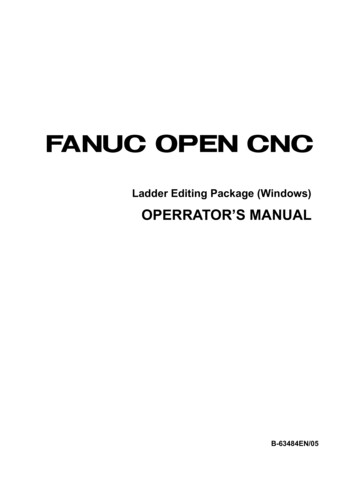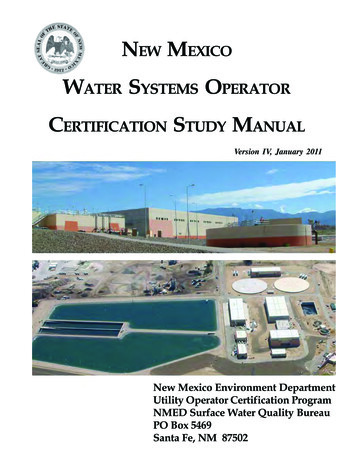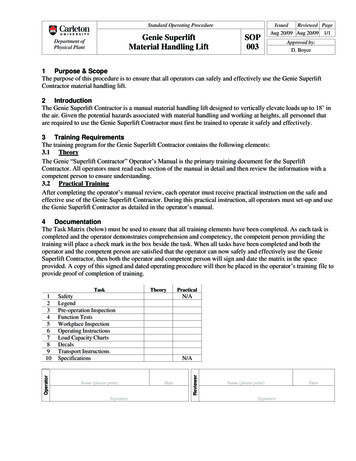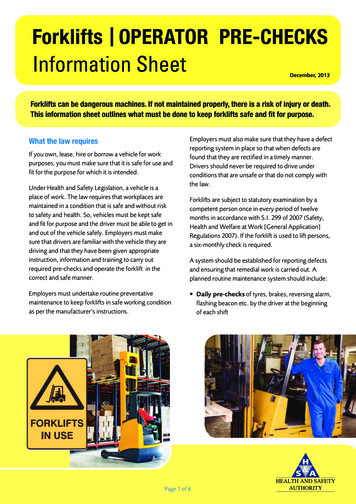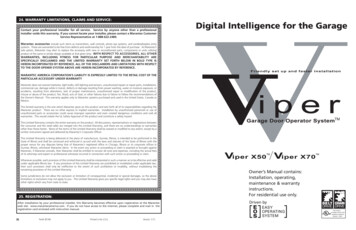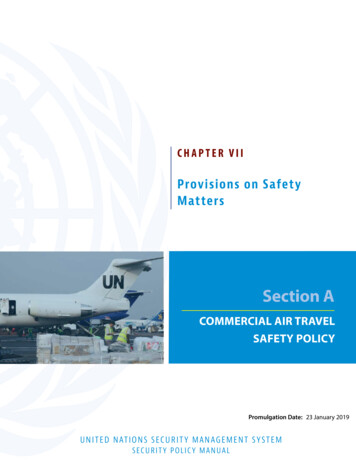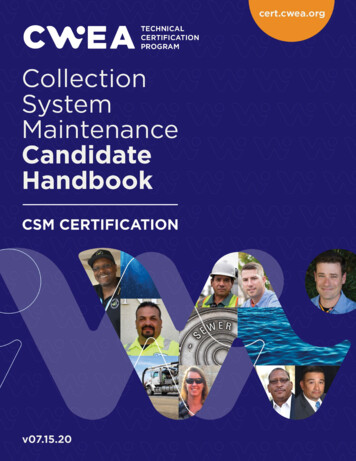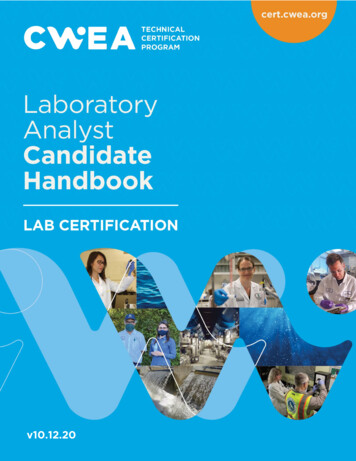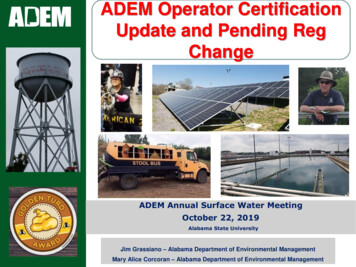
Transcription
ADEM Operator CertificationUpdate and Pending RegChangeADEM Annual Surface Water MeetingOctober 22, 2019Alabama State UniversityJim Grassiano – Alabama Department of Environmental ManagementMary Alice Corcoran – Alabama Department of Environmental Management
The State of Operator Issuesin Alabama Resurgence in the value ofcertification Operator Inventory Obtaining certification hasbecome more challenging Exam pass rates Pending revised operatorcertification regulation
Utility Managers Water & Sewer Boards, Mayors,and Municipal Governance need tounderstand: Just ‘anyone’ can’t become certified,particularly at higher grade levels Invest in/select good candidates Acknowledge their certification
Operator Inventory(as of 9/8/19) Total Certified WaterOperators: 2536Est. No. ofSystems(579 TotalSystems)– This total number consists of 780 Grade IV Water Operators207 Grade III Water Operators834 Grade II Water Operators715 Grade I Water Operators 7926282192
Operator Inventory(as of 9/8/19)No. ofSystems(482 Plants) Total Certified WastewaterOperators: 1572– This total number consists of 593 Grade IV Wastewater Operators162 Grade III Wastewater Operators280 Grade II Wastewater Operators124 Grade I Wastewater Operators413 Grade IC Wastewater Operators 37 (IV) 77 (III) 208 (II) 160 (I) 510 (IC)
Operator Inventory(as of 9/8/19) We have 4108 Certifications issued There are 658 people dual certified Overall, we have 3450 people certified inWater and Wastewater programsadem.alabama.gov
Our Workforce 12-YearTrend(No. of Operators)
Our Workforce Trend(12-year No of Operators)
Our Workforce Trend(A closer year look)
Our Workforce Trend(No. of Water Operators)
Our Workforce Trend(No. of Wastewater Operators)
Our Workforce Trend(No. of Dual-Certified Operators)
Water Exam Pass Rates(as of 9/7/19)
# Water Exams Taken(as of 9/7/19)
Avg Grade IV Exam Score
Some Trends We have a historically high number of people taking both Water andWW certification exams in the last two years (likely due to anincreasing number of pending retirements) Very few people take the Grade I WW exam or the Grade III Waterexam (in FY19: 13 and 12, respectively) Pass rates on BOTH Grade IV exams are rather low in FY19:o About 32% Watero About 18% Wastewater Many people are still complaining about the Grade IV pass ratesoverall
Some Trends The FY19 pass rates are not historic lows Grade IV pass rates and exam scores havegenerally been declining in recent years We also have some people complaining aboutpass rates on EVERY exam (e.g., Grade IIWater and WW, even though pass rates areabout 40%)
Some Trends We have many people striving to pass an examthey are not prepared to take
ExampleGrades
ExampleGrades
ExampleGrades
ExampleGradesGod bless their tenacity.!!They don’t give up, they arelearning their trade, andgetting it done.!!
Based on examperformance The exam process works well It is a distinguishing factor in developing,identifying and ultimately certifyingtalented operators Certification at ANY level is quite anaccomplishment Higher certification is very notable
The “State” of CertificationFederal regulation and oversight is changing. What we have done in the pastis no longer considered acceptable. The ‘validity’ of exams is an issue The development of exams undergoes amuch more rigorous and prescriptive process It’s no longer acceptable to just put togethera local committee of knowledgeable ‘experts’to develop Alabama exams EPA is looking at state OC programs moreclosely (pass rates, classification,enforcement, etc.)
Future Regulation ChangeADEM is developing a major Operator Certification regulation change: The existing plant classification processis over-simplified and somewhatarbitrary– 4.99 MGD WWTP is a grade III plant– 5.00 MGD WWTP is a grade IV plant– Basic GWT grade II; Adv GWT grade III– All surface water plants are grade IV WTPs– Most membrane plants are grade III or IVWTPs, but also have grade II
Future Regulation ChangeADEM is developing a major Operator Certification regulation change: All exams will be standardized exams All plants will undergo a numericalranking process to better define plantclassification Some plant grades will change. Mostwill stay the same. Some will go upand some will go down
Future Regulation ChangeSome other significant changes: A candidate will have to pass a grade IIexam prior to taking a grade III or IVexam Distribution and Collection systems willalso undergo a classification process.Grade IDGrade IIDGrade IIID MaybeGrade IVDGrade ICGrade IICGrade IIIC MaybeGrade IVC
Future Regulation Change It will be the most significant change inADEM’s OC history since the inceptionof the original rule We are now drafting and developingthe revised regulation We will have a number of public forumsto discuss the draft regulation It will go to public notice (mid 2020)
Present WWClassification MatrixADEMStandard ABCGrade IVTreatmentGrade III?Grade IIIGrade II?Grade II?Grade IDoes Not Exist?Grade IVCDoes Not Exist?Grade IIICDoes Not Exist?Grade IICGrade I (Lagoons)CollectionGrade IVGrade ICGrade ICAL Prescriptive Exams
Present WaterClassification MatrixADEMStandard ABCGrade IVTreatmentDistributionGrade IVGrade III?Grade IIIGrade II?Grade IIDoes Not Exist?Grade IDoes Not Exist?Grade IVDDoes Not Exist?Grade IIIDDoes Not Exist?Grade IIDGrade IDGrade IDAL Prescriptive Exams
Presently We are far removed from the nationalstandard examsWe need to comply with standardization orapproach it more closely
How far do we want to go? Fully Comply with Standardization?Or Get a little closer to Standardization?Or Get much closer to Standardization?
Proposed RankingProcess - Water New ranking process intended to besimple and streamlined– Numerical ranking with 4 grades of Treatment– Only a few minutes to complete
Proposed RankingProcess - Water Based on:– Flow– Water source & variation of raw water– Unit processes in the system– Plant automation– Residuals disposal
Proposed RankingProcess - Water Distribution based on population––––Grade ID 1,500 or lessGrade IID 1,501 to 15,000Grade IIID 1,501 to 50,000Grade IVD 50,001 and greater Adding Grade I Treatment Adding Grade ID and IID Maybe adding grade IIID and IVD
Proposed RankingProcess - Water All exams will be the standardized ABCexams Grade will be based on number of points– Grade I– Grade II– Grade III– Grade IV 30 points or less 31 to 55 points 56 to 75 points 76 points and greater
Proposed RankingProcess - Water The following ranking slightly altered fromthe ABC ranking Sample ranking for Attalla WaterTreatment Plant (Currently Grade IV) Size based on design flow: (2.16 MGD)Size (1 point minimum to 20 point maximum)Design flow average day, or peak month's average day, whichever is larger (1 point per 0.5 MDG. Round up.)Design flow: Consider this to be the design capacity of the plant. Examples: 9.2 MGD 19 points; 4.7 MGD 10points1 - 205
Proposed RankingProcess - WaterWater Supply Sources (Rating based on public health ter under direct influence of surface water (GWI)Surface waterAverage Raw Water Quality Variation (0 to 10 point maximum). Applies to all sources (surface andgroundwater). Key is the effect on treatment process changes that would be necessary to achieve optimizedperformance.- Little or no variation - no treatment provided except disinfection (0 points)- Minor variation - e.g. "high quality" surface source appropriate for slow sand filtration (1 point)- Moderate variation in chemical feed, dosage changes made: monthly (2 points), weekly (3 points), or daily (4points)- Variation significant enough to require pronounced and/or very frequent changes (5 points)- Severe variation - source subject to non-point discharges, agricultural/urban storm runoff, flooding (7 points)- Raw water quality subject to agricultural or municipal waste point source discharges (8 points)- Raw water quality subject to industrial waste pollution (10 points)Raw water quality is subject to:- Taste and/or odor for which treatment process adjustments are routinely made 1- Color 15 CU (not due to precipitated metals) - see exceptions in Note 1 at end of table 1- Iron or/and manganese MCL: Fe (2 points), Mn (3 points) (3 points maximum allowed) - see exceptions inNote 1 at end of table 1- Algal growths for which treatment process adjustments are routinely made 1008100-1080232-333
Proposed RankingProcess - WaterChemical Treatment/Addition ProcessesFluoridationDisinfection/Oxidation (Note: Points are additive to a maximum of 15 points allowed for this category.)CHECK ALL THAT APPLY:-Chlorination:'-Hypochlorites . (5 points)'-If generated on site . (1 point)'-Chlorine gas . (8 points)'-Chloramination . (10 points)'-Chlorine dioxide . (10 points)-Ozonation . (10 points)-UV Radiation . (2 points)-Iodine, Peroxide, or similar . (5 points)-Potassium permanganate (without greensand filtration) . (4 points)pH adjustment for process control (e.g. pH adjustment aids coagulation)Stability or Corrosion Control (If the same chemical is used for both Corrosion Control and pH adjustment,count points only once)Coagulation/Flocculation & Filter AidPrimary coagulant additionCoagulant aid / Flocculant chemical addition (in addition to primary coagulant use)FlocculationFilter aid addition (Non-ionic/anionic polymers)Clarification/SedimentationSedimentation (plain, tube, plate)Contact adsorptionOther clarification processes (air flotation, ballasted clarification, etc.)Upflow clarification ("sludge blanket clarifier") 240-1544622246688
Proposed RankingProcess - WaterFiltrationGranular media filtration (Surface water/GWI) 3 gpm/sq ftGranular media filtration (Surface water/GWI) 3 gpm/sq ftGroundwater filtrationMembrane filtration- For compliance with a primary regulation (10 points)- For compliance with a secondary regulation (6 points)Diatomaceous earth (pre-coat filtration)Cartridge/bagPre-filtration (staged cartridges, pressure sand w/o coagulation, etc.): add one point per stage to maximum of3 pointsSlow sandOther Treatment ProcessesAerationAir stripping (including diffused air, packed tower aeration)Ion-exchange/softeningGreensand filtrationBackwashable multi-media pre-filtrationLime-soda ash softening (includes: chemical addition, mixing/flocculation/clarification/filtration - do not addpoints for these processes separately)Granular activated carbon filter (do not assign points when included as a bed layer in another filter)Powdered activated carbonBlending sources with significantley different water quality- To achieve MCL compliance (4 points)- For aesthetic reasons (2 points)Reservoir management employing chemical 0522-42158
Proposed RankingProcess - WaterResiduals Disposal- Discharge to surface, sewer, or equivalent (0 points)- On-site disposal, land application (1 point)- Discharge to lagoon/drying bed, with no recovery/recycling - e.g. downstream outfall (1 point)0-3- Backwash recovery/recycling: discharge to basin or lagoon and then to source (2 points)- Backwash recovery/recycling: discharge to basin or lagoon and then to plant intake (3 points)Facility CharacteristicsInstrumentation - Use of SCADA or similar instrumentation systems to provide data, with:- Monitoring/alarm only, no process operation - plant has no automated shutdown capability (0 points)- Limited process operation - e.g. remote shutdown capability (1 point)0-4- Moderate process operation - alarms and shutdown, plus partial remote operation of plant (2 points)- Extensive or total process operation - alarms and shutdown, full remote operation of plant possible (4points)Points based on 335-10-x-.xxClassification based on 335-10-x-.xx1457.0Grade III
Current Status of WTPClassificationsAlabama WTP Classification OverviewCurrent Status (2019)300Number of Plants)25020015010049% Grade IIN/A5014% Grade IV4.5% Grade III0Grade I (Distribution)Grade II WTPGrade III WTPGrade IV WTP
Future Status of WTPClassifications We envision the classification of plantsbeing more broadly distributed
Proposed WTP numericalrankings These plants were not randomly chosen Something unique about these plants– Thought they would be likely to changegradesPlantCurrent RankingProposed RankingAlabaster (plant #1)IVIIIAlabaster (plant #2)IIIIAttallaIVIIIClay CountyIVIVWest BarbourIII
Proposed RankingProcess - Wastewater Based on:– Population– Flow– I&I Impacts– Industrial sources present– Unit processes in the system– Treatment limits– Plant automation– Laboratory analysis accomplished– Biosolids processes
Current Status of WWTPClassificationsAlabama WWTP Classification OverviewCurrent Status (2019)250Number of Plants20015043% Grade II10033% Grade I5016% Grade III8% Grade IV0Grade I (Lagoon)Grade II WWTPGrade III WWTPGrade IV WWTP
Future Status of WWTPClassifications We also envision the classification ofwastewater plants being more broadlydistributed On-Site WWTPs may also be adopted intothe WW Certification Program
Proposed WWTPnumerical rankingsPlantCurrent RankingProposed RankingIIIBrantley LagoonIICentre LagoonIIIIIIVIIII* EufaulaIIIII* Hoover InvernessIIIIVLittlevilleIIIIMaplesvilleIIIIMuscle ShoalsIIIIIIIIIIVIIII* Attalla* DaphneEast Walker* Prattville Pine CreekValley Junior High School
How will this affect ourcurrent operators?It should not: We will implement a major grandfatheringclause for operators working at a plantthat increases in grade
How will this affect ourcurrent operators?For example, if you work at a Grade IIIplant and the plant is deemed a Grade IVplant: All current Grade III operators at the plantwill also be given a “Restricted’ Grade IVCertification
What about existing GradeIII WW Plant Waivers?If a plant is upgraded to a Grade IV WWplant, the waiver will remain in place Proposing that all Grade III and alsoGrade IV Plants with a flow of up to 4.99MGD may pursue a waiver
All Operators will berequired To notify ADEM’s Operator CertificationProgram about where the operator isemployed & when employment changes Multiple System Form must be submittedto ADEM’s OC Program by all operatorsworking at more than one plant (Actually,we envision using one form for all operatoremployment notifications)
Multiple SystemsOperators Operator must obtain approval to operateeach and every system the person claimsto operate Operator will be responsible for ensuringthe safe, effective, and proper operation ofall plants and systems operated Plants to be operated must be within a 50Mile radius of the operator’s primaryresidence
Adopting a new requirement foroperator in “Direct Responsible Charge”Primarily for Operator Interns The plant must designate that an Intern isin DRC of a plant or of a major componentof a plant and that he/she is working underthe direct supervision of a certifiedoperator of the same grade or higher thanthe grade pursued by the intern
Collection & DistributionSystem Operators Every public wastewater collection andwater distribution system must have acertified operator in responsible charge ofthe collection and distribution systems In most cases, this should be someonewho is NOT working as the treatmentsystem operator
Work Shift Limit The same operator may not work a shiftgreater than 16-hours per day without priorwritten approval from the Director Short-term exceptions may be grantedduring weather emergencies, poweroutages, or plant upset
Test taking restriction Upon failure of three-consecutive examsfor the same grade within a six-monthperiod, the applicant must wait 6-monthsbefore applying to take a repeat exam
Certificate Expiration Late fees are still applicable if a certificateis not renewed 30-days prior to expiration Presently, if an Operator did not attain hisor her CEHs prior to the expiration date,the operator’s certification is lost We are changing this requirement to allowan operator a sunset period of one-year toattain re-certification
Certificate Expiration Incremental late fees will be issued:– Basic late fee ( 215)– 6-month late period (TBD but higher )– 24-month late period (TBD but incrementallyhigher ) Operator remains uncertified during thislapse period
Reciprocity Only granted if the operator passes acomparable written exam in a reciprocalstate [i.e., no ‘reciprocity of a reciprocity’] We WILL consider accepting reciprocitywith states that presently do not offerreciprocity with Alabama (e.g., Florida,California)
Training Class CEHAllocations Some specificity will be added to clarifythe type and number of CEHs accepted ina given 3-year renewal period
Revocation of Certificate Adding a provision for revocation if anoperator falsifies documented workexperience or time worked in DirectResponsible Charge
On-Line Renewal Will be required(i.e., mail-in renewals will not be accepted)
Automated RenewalThough not part of the regulation, ADEM willbe launching an automated renewal processsometime in the future (possibly 2021) An Operator will renew on-line and beissued a renewal card that he or she willbe responsible for printing out
Automated RenewalThis is a ‘trust but verify’ process ADEM’s Operator Certification Programwill do more random audits of renewalsonce this automated renewal program isimplemented: The operator should keep detailed recordsof training activities, in the event he/she isaudited
All Forms will be revised Form 435 Operator Renewal (on-line) Form 505 (exam application) Form 506 (Operator ExperienceVerification) Form 507 (Reciprocal Application) Form 508 (Multiple Systems Application –will be revised to be a required “OperatorEmployment Form”)
Plant Ranking Sheet Will be placed on the OperatorCertification Web Page Plant management/chief operator will berequired to complete the ranking for eachplant one time Plant must revise the ranking in the future,if plant changes occur that warrant reranking
Plant Re-ranking Should rarely occur Plant management/chief operator will berequired to re-rank the plant whennecessary ADEM will implement a grandfathering ofplant operators at the time of re-ranking, ifnecessary
Questions.?Jim GrassianoChief, Compliance Assistance &Operator Certification y Alice CorcoranCompliance Assistance &Operator Certification -7872
The State of Operator Issues in Alabama Resurgence in the value of certification Operator Inventory Obtaining certification has become more challenging Exam pass rates Pending revised operator certification regulation
